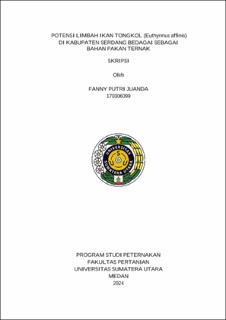Potensi Limbah Ikan Tongkol (Euthynnus Affinis) di Kabupaten Serdang Bedagai Sebagai Bahan Pakan Ternak
| dc.contributor.advisor | Siregar, Galih Ari Wirawan | |
| dc.contributor.advisor | Umar, Sayed | |
| dc.contributor.author | Juanda, Fanny Putri | |
| dc.date.accessioned | 2024-08-07T03:55:02Z | |
| dc.date.available | 2024-08-07T03:55:02Z | |
| dc.date.issued | 2024 | |
| dc.identifier.uri | https://repositori.usu.ac.id/handle/123456789/95036 | |
| dc.description.abstract | The scarcity of fishmeal raw materials encourages the need for innovation and alternatives. One of the alternatives used is fish waste which is utilized as fishmeal. This research was conducted in Serdang Bedagai Regency, North Sumatra Province. The purpose of this study was to determine the description of tuna (Euthynnus Affinis) waste, the quality of fishmeal produced and the potential of fishmeal from tuna (Euthynnus Affinis) waste obtained in the study area. The research method used was survey method with respondents being fish collectors in TPI of Serdang Bedagai Regency. The sampling method used was snowball sampling. The results showed that the proportion of tuna waste to tuna (Euthynnus Affinis) in Serdang Bedagai Regency was 47%/Kg fish weight. The conversion of tuna waste into fishmeal was 13%/fresh waste, with BK content of 90.33%, Ash content of 23.5%, Crude Fiber 1.04%, Crude Fat 19.1%, and Protein 34.8%. The potential of fishmeal that can be produced from tuna waste (Euthynnus Affinis) 2024-2028 is 1,677 tons, 1,803 tons, 1,930 tons, 2,057 tons, and 2,184 tons, respectively. | en_US |
| dc.language.iso | id | en_US |
| dc.publisher | Universitas Sumatera Utara | en_US |
| dc.subject | Euthynnus Affinis | en_US |
| dc.subject | Serdang Bedagai Regency | en_US |
| dc.subject | Fishmeal | en_US |
| dc.subject | SDGs | en_US |
| dc.title | Potensi Limbah Ikan Tongkol (Euthynnus Affinis) di Kabupaten Serdang Bedagai Sebagai Bahan Pakan Ternak | en_US |
| dc.title.alternative | Potential of Little Tuna (Euthynnus Affinis) Fish Waste in Serdang Bedagai Regency as an Animal Feed Ingredient | en_US |
| dc.type | Thesis | en_US |
| dc.identifier.nim | NIM170306099 | |
| dc.identifier.nidn | NIDN0103018904 | |
| dc.identifier.nidn | NIDN8858650017 | |
| dc.identifier.kodeprodi | KODEPRODI54231#Peternakan | |
| dc.description.pages | 55 Pages | en_US |
| dc.description.type | Skripsi Sarjana | en_US |
Files in this item
This item appears in the following Collection(s)
-
Undergraduate Theses [805]
Skripsi Sarjana


